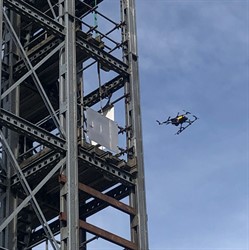
A drone being used for remote visual inspection
The challenge
The visual inspection of critical assets is a cornerstone of
asset integrity assurance and is often the primary means of
detecting surface flaws and corrosion damage. Such inspections are
traditionally conducted at close range by specialist engineers,
however where inspections need to take place in difficult-to-access
locations such as in confined spaces or at height, then advances in
RVI technologies could remove the need for human presence in
hazardous environments.
Given the potential consequences for RVI equipment to miss or
underestimate the condition of assets under inspection, the
capabilities and limitations of RVI methods needed to be
systematically explored and an evidence base developed to help
inform decision making.
In 2024, HSE, together with 15 industry stakeholders, completed
a shared research project looking at the viability and capability
of remote visual inspection (RVI) technologies and equipment.
What we did
Following a workshop with industry operators, inspection
companies and regulatory bodies, HSE identified a number of
knowledge gaps and initiated a shared research project focusing on
the use of drone and borescope technologies, the latter used for
access to small internal spaces with insufficient access for
drones.
The project included a series of inspection trials, which took
place at the HSE Science and Research Centre in Buxton, on indoor
and outdoor structures containing various materials and defect
types. Five inspection companies participated in these 'blind
trials' using drones and the results were combined to give an
overall indication of the accuracy of examination using RVI
technology compared to a conventional human) inspection.
Over 40 different sample combinations were inspected and over
350 individual inspection results were analysed by HSE scientists.
The analysis of the results focused on the ability of technicians
using RVI to find, characterise and quantify a wide range of
features and defect types.
The outcome
The project finished in 2024, with the issue of a series of
reports to the sponsor group providing the evidence base for what
can be expected from currently available drone technologies and
including guidance on optimising the outcome of inspections.
Two good practice guides were also issued: one on drone
inspection and one on the use of borescopes. A series of publicly
available outputs will be published by the Energy Institute in
2025.
David Johnson, HSE's Deputy Chief Scientific Adviser, said:
'HSE's shared research model is very effective for
identifying and resolving health and safety issues that are of
interest to both industry and us as a regulator. Working together
and sharing our experiences, insights and resources leads to a
better outcome for all parties and a culture of continuous
improvement and healthier and safer working
practices'.
Interested in our current shared research opportunities? Visit
our Shared
Research page to find out more.